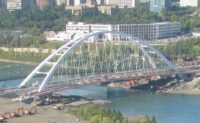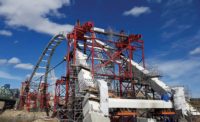High winds have drawn a great deal of speculation. Gusts of up to 70 kilometers an hour may have reached 120 km per hour in the area of the bridge, which sits in a valley that can act like a wind tunnel, according to a staffer for Edmonton Councilor Michael Oshry, who was briefed on the review. The city's structural consultant is trying to "cross-tabulate" the impact of high winds with other potential factors, such as fabrication flaws.
Among the questions being asked is whether the load being placed on the beams was distributed evenly, says the councilor's staff member.
Brace design and erection procedures are another likely focus, city engineering officials confirmed. Cruz Noguez believes the city will closely examine and test the girders for fractures. "Even if they can make it [the girders] perfectly straight, a very serious study of the steel still needs to be done," he said. "Geometry is not everything."
In a statement, the city's engineering department said only that "further detailed analysis of the girders will be required to determine what corrective measures will be required."
Bracing systems should never be given short shrift in bridge design, even when there are no curves in the structure, says the U.S. Dept. of Transportation's handbook on bracing-system design for steel bridges. The need for torsional stiffness in horizontally curved girders is relatively obvious, write the authors, since the girders are subjected to large torques due to the geometry of the bridge. However, understanding the necessity of adequate torsional stiffness in straight girders is also important, since lateral-torsional buckling often controls the design of the girders during construction.
For now, patience will be needed in Edmonton. The necessary tests and examinations of the girders and bridge are complicated by the bustling four-lane road beneath. About 40,000 vehicles use Groat Road each day, which means engineers and other consultants will have limited hours—either over the weekends or late at night, long after commuters have reached home—to investigate, city officials say. Weeks may be needed to finish.
Moving Forward
"The contractors will continue working on a plan for a detailed analysis of the girders and lay out a new schedule for the project," said Belcourt in a statement. "We will know more in the weeks ahead how construction will move forward."
The quick dissemination of the buckled-girder images recorded at the jobsite triggered an unusual amount of speculation about what happened, including guesses by local "armchair engineers" intrigued by the mystery.
Real engineers, however, were willing to speculate. One engineer, commenting on ENR.com, theorized that both the web and flange of the deep girders had been underdesigned. "I've seen this before," he wrote.
Another engineer spoke mostly of the braces. From some of the photos, it "looks like some braces that were placed buckled when the overall girders buckled. A question that could be asked is, whether or not these were temporary braces and how they were designed."
Of course, the same photos that make for interesting classroom case studies have the potential to become evidence in claims that pin heavy losses on the project team members and their insurers. In a written description for an Edmonton newspaper, Cruz Noguez said he couldn't immediately recall any instances of girders that were reused after buckling in such dramatic fashion.








Post a comment to this article
Report Abusive Comment